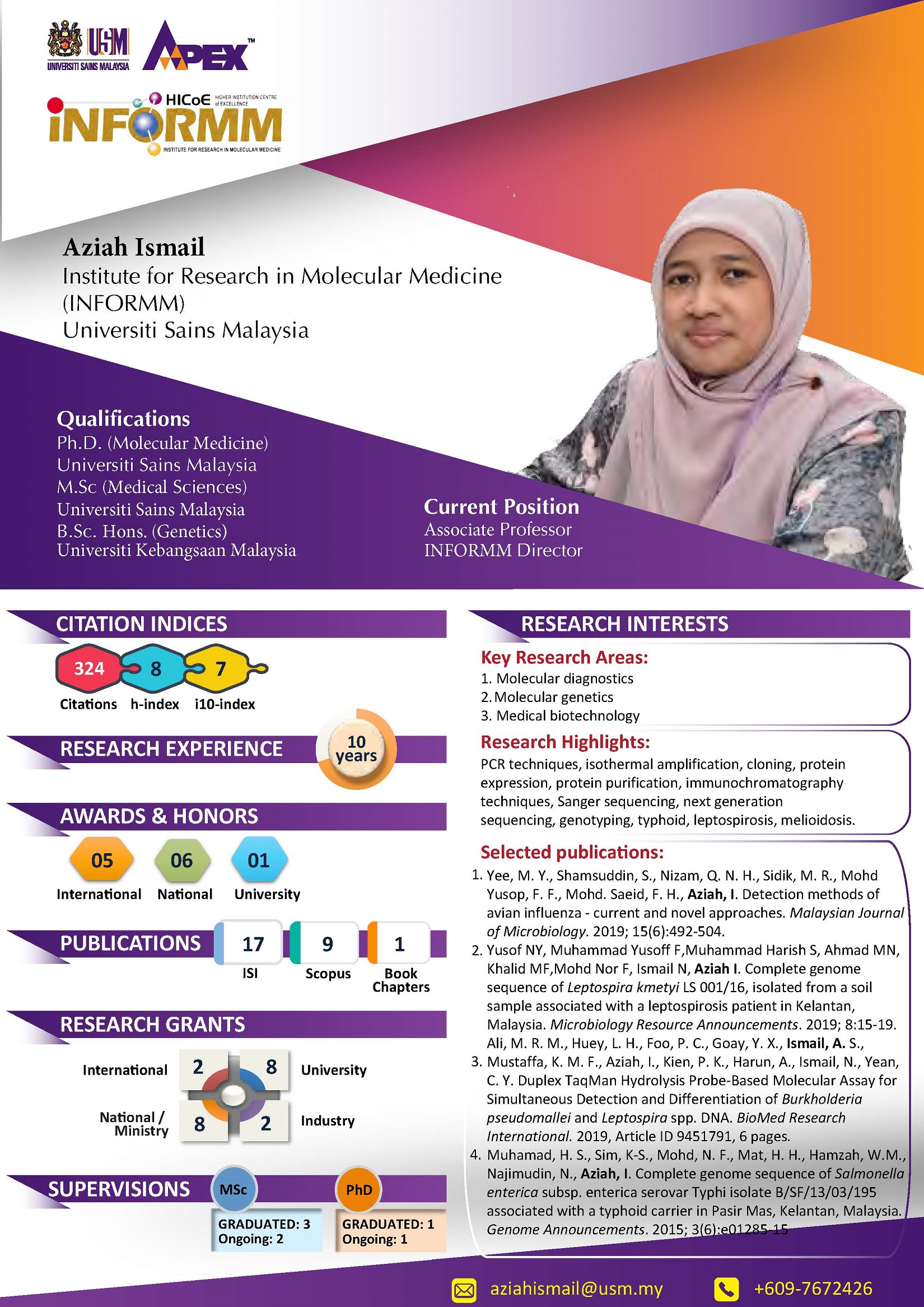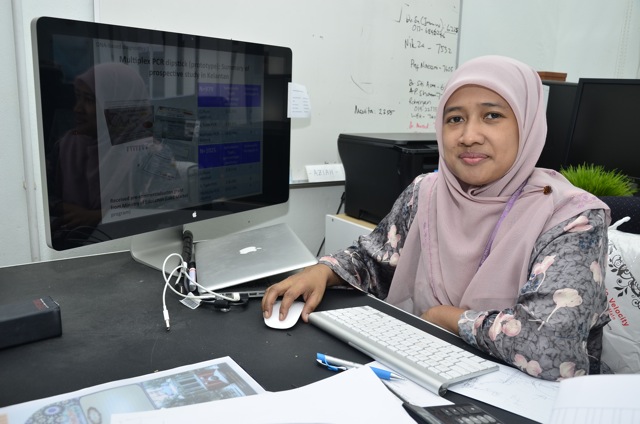Aziah Ismail


Name
Aziah Ismail
Current Position
Associate Professor
aziahismail@usm.my
Office Telephone
+609-7672426
Qualifications
Universiti Sains Malaysia, PhD in Molecular Medicine, 2009
Universiti Sains Malaysia, MSc in Medical Sciences, 2002
Universiti Kebangsaan Malaysia, BSc (Hons.) in Genetics, 1994
Research Interests
Molecular diagnostics, bacterial genome sequencing, molecular genetics
Research Overview 1
Bacterial diseases
My research interests are in the field of microbial genomics and proteomics including various PCR techniques, isothermal amplification, cloning, protein expression, protein purification, immunochromatography techniques, Sanger sequencing, next generation sequencing as well as single nucleotide polymorphism (SNP) analysis. I am involved in the development of molecular diagnostics using PCR as well as isothermal amplification as well as DNA dipstick detection method using lateral flow technology for the detection of Salmonella Typhi and Salmonella Paratyphi A in carriers. I was also awarded a pre-commercialization grant from the Ministry of Education Malaysia for DNA diagnostics for typhoid carriers. I am also involved in bacterial genome sequence analysis for Salmonella strains isolated from such samples, SNP marker analyses for tuberculosis susceptibility; and proteomic approaches to identify specific markers for diagnostic purposes. I had secured several research grants in the development of diagnostics from the university, Ministry of Education as well as one from the industry. Currently my research area is moving towards one health approach for zoonotic diseases such as leptospirosis and melioidosis in collaboration with other institutions and government agency.
Scientific Research Overview
Current projects in the lab include:
1. Molecular diagnostics for infectious diseases
Nucleic acid-based diagnostics using the established PCR and isothermal platforms for infectious diseases: typhoid, paratyphoid, leptospirosis, melioidosis, tuberculosis
a. Cross priming amplification-lateral flow assay for the detection of Salmonella enterica serovar Typhi & Salmonella enterica serovar Paratyphi A from environmental system
b. Recombinase polymerase amplification for the detection of Mycobacterium tuberculosis
c. PCR (symmetric and asymmetric)- lateral flow assay for pathogenic Leptospira spp. and Bukholderia pseudomallei
2. Interrelationship between human melioidosis and distribution of Bukholderia pseudomallei in animals and environmental samples
3. Whole genome sequencing of Salmonella enterica serovar Typhi, pathogenic Leptopspira spp. and Bukholderia pseudomallei
Selected Publications
1. Muhamad Harish S, Sim K-S, Najimudin N, Aziah I. 2015. Genome sequence of Salmonella enterica subsp. enterica serovar Typhi isolate PM016/13 from untreated well water associated with a typhoid outbreak in Pasir Mas, Kelantan, Malaysia. Genome Announc 3(6):e01261-15. doi:10.1128/genomeA.01261-15.
2. Muhamad Harish S, Sim K-S, Mohd Nor F, Mat Hussin H, Hamzah WM, Najimudin N, Aziah I. 2015. Complete genome sequence of Salmonella enterica subsp. enterica serovar Typhi isolate B/SF/13/03/195 associated with a typhoid carrier in Pasir Mas, Kelantan, Malaysia. Genome Announc 3(6):e01285-15. doi:10.1128/genomeA.01285-15.
3. AL Chua, I Aziah, P Balaram, S Bhuvanendran, AA Anthony, SN Mohmad, NM Nasir, H Hassan, R Naim, LP Meran, HM Hussin and A Ismail, Identification of Carriers Among Individuals Recruited in the Typhoid Registry in Malaysia Using Stool Culture, Polymerase Chain Reaction, and Dot Enzyme Immunoassay as Detection Tools, Asia-Pacific Journal of Public Health, 2015, Vol. 27(2), September 20 (Epub). DOI: 10.1177/1010539512458521
4. Eugene Boon Beng Ong Amy Amilda Anthony, Aziah Ismail, Asma Ismail, Theam Soon Lim. Cloning, expression, and purification of the hemolysin/cytolysin (HlyE antigen) from Salmonella enterica serovar Typhi: potential application for immunoassay development, Diagnostic Microbiology and Infectious Disease. 77 (2013) 87–89.
Author Links
